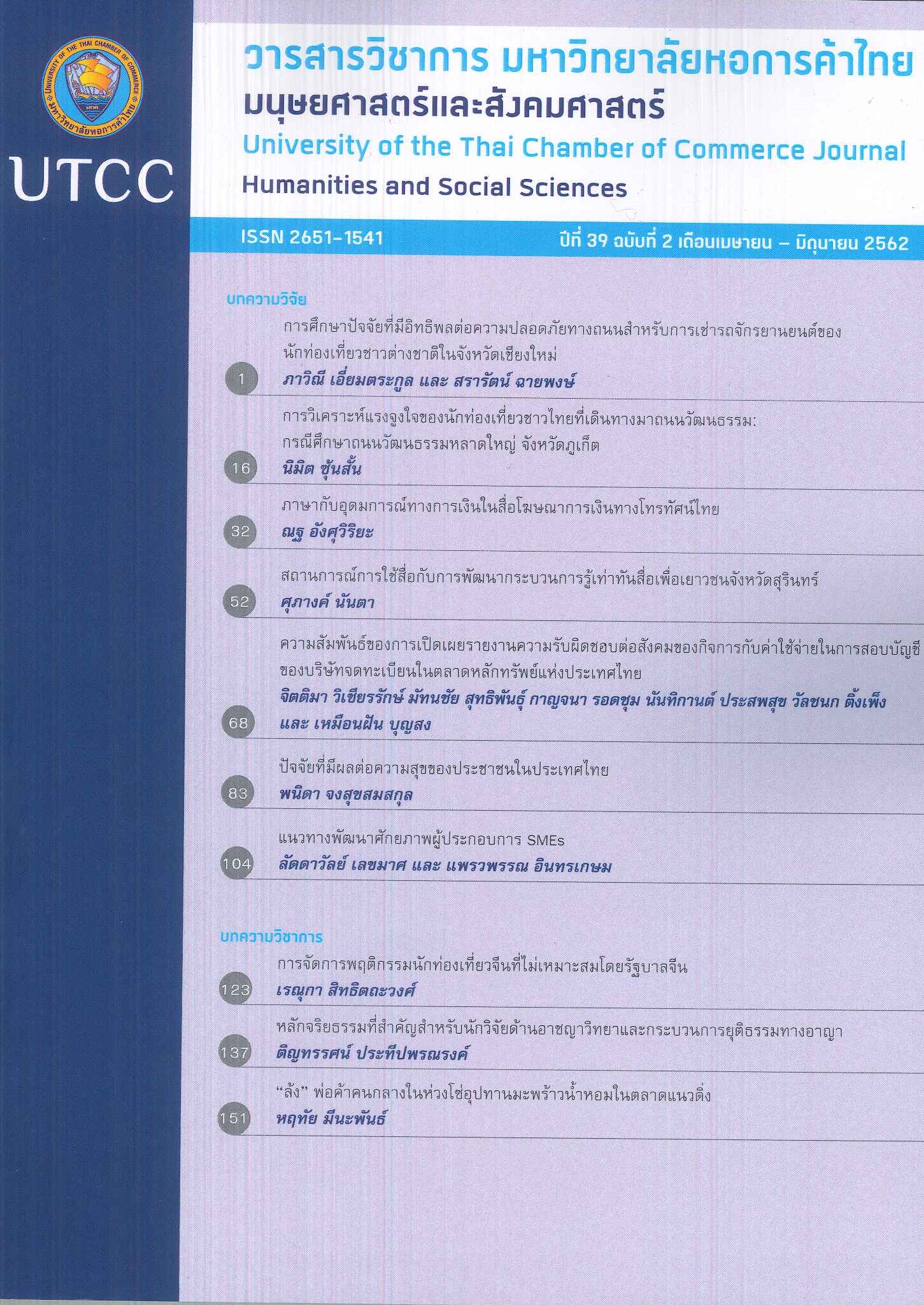Potential Development Guidelines of SMEs
Main Article Content
Abstract
This research aims to study the problems of SMEs and the evaluation of a project outcomes for ‘developing the potential of SMEs, particularly training and company visit programs as well as coaching, counselling and mentoring from large companies for SMEs competitiveness enhancement. The data was collected from different approaches including a focus group of 16 organizations from both the public and private sectors, questionnaire and assessment forms for business health check and the project evaluation. According to the problems faced by SMEs businesses, the findings indicate that ‘production’ is the major constraint in operating their business, followed by ‘distribution and logistics’, ‘marketing’, ‘accounting and finance’, and ‘administrative and management, respectively. In addition, the results show that the SME development project in terms of coaching, counselling, mentoring and training from large companies is an effective way to enhance SMEs’ performance. SMEs can improve their performance after participating the project during 12 month. This project not only helps SMEs to solve their business problems but also to develop good business strategies and concepts and then to enhance their performance. The KPIs of the project are attained since SMEs can achieve better performance such as increased sales, cost reduction, business expansion, personnel efficiency, and product image enhancement. Therefore, the government should support and promote SMEs by developing and implementing the project that can effectively solve SMEs’ business problems and improve SMEs’ performance. This study suggests that counselling, mentoring and training can support SMEs to achieve sustainable competitive advantage.
Article Details
ลิขสิทธิ์ของบทความ
ผลงานที่ได้รับการตีพิมพ์ถือเป็นลิขสิทธิ์ของมหาวิทยาลัยหอการค้าไทย ห้ามมิให้นำเนื้อหา ทัศนะ หรือข้อคิดเห็นใด ๆ ของผลงานไปทำซ้ำ ดัดแปลง หรือเผยแพร่ ไม่ว่าทั้งหมดหรือบางส่วนโดยไม่ได้รับอนุญาตเป็นลายลักษณ์อักษรจากมหาวิทยาลัยหอการค้าไทยก่อน
References
ปาริฉัตร จันโทริ. (2558). การศึกษาเปรียบเทียบรูปแบบการประกันคุณภาพในสถาบันอุดมศึกษาไทย. วารสารศึกษาศาสตร์ มหาวิทยาลัยสงขลานครินทร์ วิทยาเขตปัตตานี, 26(1), 1-16.
รัตนะ บัวสนธ์. (2552). ปรัชญาการวิจัย. กรุงเทพฯ: สำนักพิมพ์แห่งจุฬาลงกรณ์มหาวิทยาลัย.
ลัดดาวัลย์ เลขมาศ, และแพรวพรรณ อินทรเกษม. (2560). แนวทางการพัฒนากลไกตลาดผู้ให้บริการที่ปรึกษาธุรกิจอุตสาหกรรม. วารสารมหาวิทยาลัยหอการค้าไทย มนุษยศาสตร์และสังคมศาสตร์, 37(4), 169-181.
วัลนิกา ฉลากบาง. (2560). การวิจัยแบบผสมผสาน. วารสารมหาวิทยาลัยนครพนม, 7(2), 124-132.
แววดาว พรมเสน. (2554). การวิจัยเชิงคุณภาพและการวิจัยเชิงปริมาณ. วารสาร มทร.อีสาน, 4(1), 95-102.
สำนักงานรางวัลคุณภาพแห่งชาติ. (2561). เกณฑ์รางวัลคุณภาพแห่งชาติปี 2561-2562. สืบค้นเมื่อ 12 เมษายน 2561, จาก https://www.tqa.or.th/ebook/Criteria_2017_2018/html5/index.html?&locale=ENG&pn=1
สำนักงานส่งเสริมวิสาหกิจขนาดกลางและขนาดย่อม. (2560). รายงานสถานการณ์ของ SMEs ปี 2560. สืบค้นเมื่อ 12 เมษายน 2561, จาก https://www.sme.go.th/th/download.php?modulekey=215
สุภางค์ จันทวานิช. (2553). วิธีการวิจัยเชิงคุณภาพ. (พิมพ์ครั้งที่ 18). กรุงเทพฯ: สำนักพิมพ์แห่งจุฬาลงกรณ์มหาวิทยาลัยหอการค้าไทย. (2560). รายงานปรับแผนธุรกิจและเพิ่มขีดความสามารถ SMEs (พื้นที่ที่ 2). กรุงเทพฯ: มหาวิทยาลัยหอการค้าไทย.
เอื้อมพร หลินเจริญ. (2555). เทคนิคการวิเคราะห์ข้อมูลเชิงคุณภาพ. วารสารการวัดผลการศึกษา มหาวิทยาลัยมหาสารคาม, 17(1), 17-29.
Abdullah, A. (2010). Measuring TQM implementation: A case study of Malaysian SMEs. Measuring Business Excellence, 14(3), 3-15.
Alstrup, L. (2000). Coaching continuous improvement in small enterprises. Integrated Manufacturing Systems, 11(3), 165-170.
Bell, G. (2014). Coaching is key to SME success: International business coach Peter Boolkah explains why the right coach can take your business to the next level. Development and Learning in Organizations: An International Journal, 28(3), 35-37.
Bulak, M. E., & Turkyilmaz, A. (2014). Performance assessment of manufacturing SMEs: A frontier approach. Industrial Management & Data Systems, 114(5), 797-816.
Carton, R. B., & Hofer, C. W. (2006). Measuring organizational performance: Matrics for entrepreneurship and strategic management research. Northampton, England: Edward Elgar.
Cowling, M. & Oakley, J. (2009). Early assessment of business link health check. Retrieved February 20, 2016, from https://www.employmentstudies.co.uk/system/files/resources/files/bis091357.pdf
Creswell, J. W., & Clark, V. L. (2007). Designing and conducting mixed methods research. Thousand Oaks, CA: Sage.
Denzin, N., & Lincoln, Y. (2000). Handbook of qualitative research (2nd ed). Thousand Oaks, CA: Sage.
Hall, C. M. & Jenkins, J. (1995). Tourism and public policy. London, England: Routledge.
International Trade Centre. (2015). SME competitiveness outlook 2015: connect, compete and change for inclusive growth. Retrieved August 30, 2017, from https://www.intracen.org/uploadedFiles/intracenorg/Content/Publications/SME_Comp_2015_Jan_version_low_res.pdf
Kim, D. Y., Kumar, V., & Murphy, S. A. (2010). European Foundation for quality management business excellence model: An integrative review and research agenda. International Journal of Quality & Reliability Management, 27(6), 684-701.
Mann, R., Adebanjo, D., & Tickle, M. (2011). Deployment of business excellence in Asia: An exploratory study. International Journal of Quality & Reliability Management, 28(6), 604-627.
Ministry of Economic Affairs. (2014). The white paper on small and medium enterprises in Taiwan. Retrieved March 3, 2016, from https://www.moeasmea.gov.tw/lp.asp?ctNode=307&CtUnit=36&BaseDSD=7&mp=2
Mohammad, M., & Mann, R. S. (2010). National quality business excellence awards in different countries. Retrieved March 3, 2016, from https://www.bpir.com/images//d28-mus%2C%20national%20quality%20business%20excellence%20awards.pdf
Morris, M. H., Kuratko, D. F., & Covin, J. G. (2008). Corporate entrepreneurship and innovation. (2nd ed). Mason, OH: Thomson South-Western.
Narkuniene, J., & Ulbinaite, A. (2018). Comparative analysis of company performance evaluation methods. Entrepreneurship and Sustainability Issues, 6(1), 125-138.
National Institute of Standards and Technology. (2015). Baldrige performance excellence. Retrieved March 3, 2016, from https://campusservices.gatech.edu/sites/default/files/documents/assessment/2015-2016_baldridge_criteria.pdf
Organisation for Economic Co-operation and Development. (2018). Strengthening SMEs and entrepreneurship for productivity and inclusive growth. Retrieved July 10, 2018, from https://www.oecd.org/cfe/smes/ministerial/documents/2018-SME-Ministerial-Conference-Key-Issues.pdf
Politis, Y., Litos, C., Grigoroudis, E., & Moustakis, V. S. (2009). A business excellence model for the hotel sector: Implementation to high-class Greek hotels. Benchmarking: An International Journal, 16(4), 462-483.
Sakolnakorn, T. P. N. (2010). The analysis of problem and threat of small and medium-sized enterprises in Northeast Thailand. International Business & Economics Research Journal, 9(9), 123-132.
Talib, H. H .A, Ali, K. A. M., & Idris, F. (2014). Critical success factors of quality management practices among SMEs in the food processing industry in Malaysia. Journal of Small Business and Enterprise Development, 21(1), 152-176.
Wongrassamee, S. Gardiner, P.D., & Simmons, J.E.L. (2003). Performance measurement tools: the balanced scorecard and the EFQM excellence model. Measuring Business Excellence, 7(1), 14-29.

